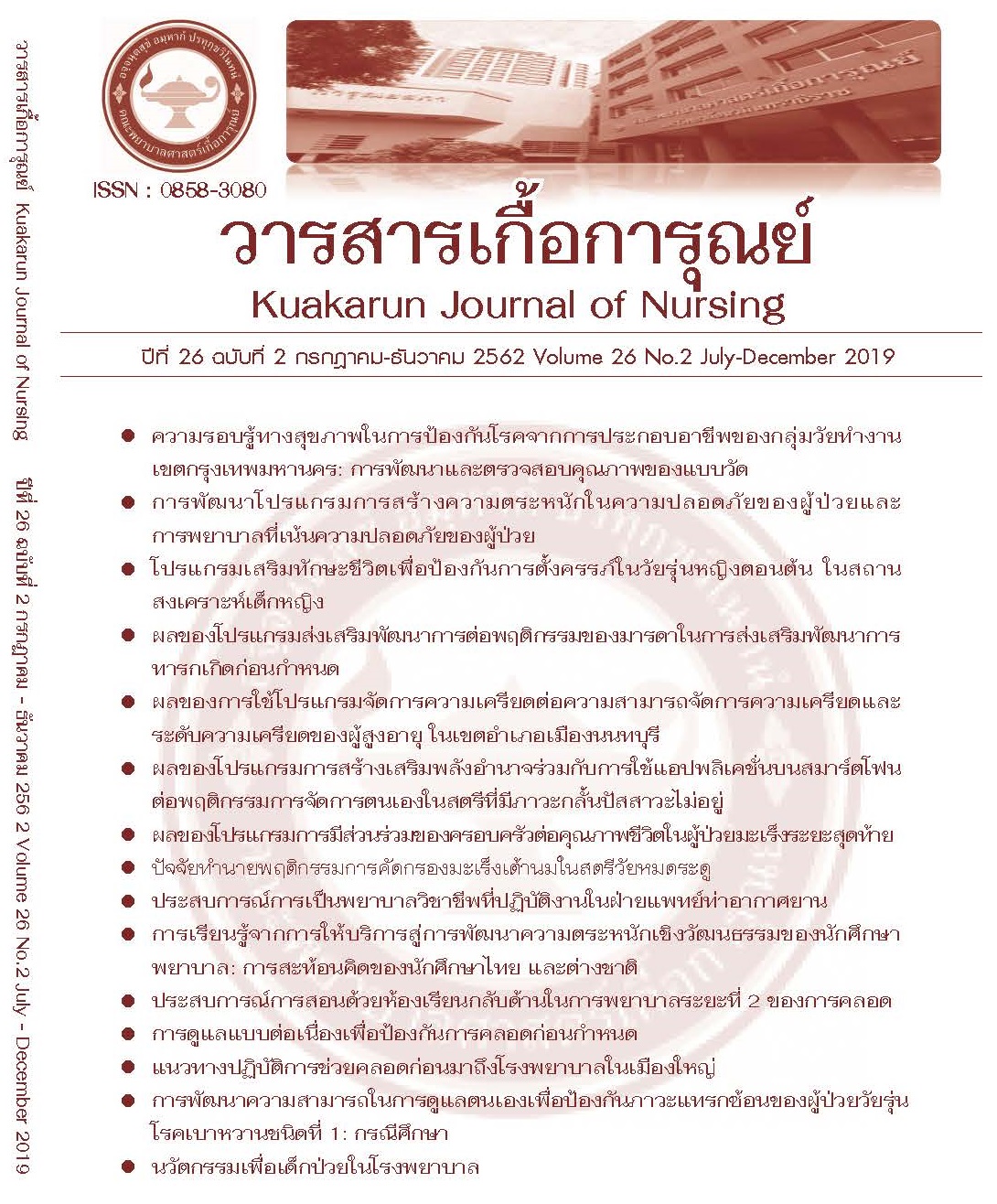ประสบการณ์การสอนด้วยห้องเรียนกลับด้านในการพยาบาลระยะที่ 2 ของการคลอด
คำสำคัญ:
ประสบการณ์การสอน, ห้องเรียนกลับด้าน, การพยาบาลระยะที่ 2 ของการคลอดบทคัดย่อ
ห้องเรียนกลับด้านเป็นการเรียนการสอนที่สามารถตอบโจทย์ผู้เรียนยุคศตวรรษที่ 21 ได้โดยผู้เรียนเรียนที่บ้าน ทำการบ้านที่โรงเรียนและผู้สอนปรับบทบาทมาเป็นผู้อำนวยความสะดวกในการเรียน การสอนแบบห้องเรียนกลับด้านถูกนำมาใช้ในการสอนหัวข้อการพยาบาลระยะที่ 2 ของการคลอดเนื่องจากหัวข้อนี้มีความซับซ้อนที่เกี่ยวเนื่องกับสุขภาพมารดาเละทารกแรกเกิด โดยเน้นให้ผู้เรียนศึกษาหาความรู้จากนอกห้องเรียนด้วยตนเอง ผ่านสื่อเทคโนโลยีที่ผู้สอนจัดทำขึ้นและสื่อสารผ่านทางเฟซบุ๊ก จากนั้นนำสิ่งที่ผู้เรียนได้เรียนรู้ ข้อสงสัยมาจัดกิจกรรมในชั้นเรียน ประสบการณ์ที่ผู้สอนได้รับ คือ การเปลี่ยนบทบาทจากผู้บรรยายหน้าชั้นเรียน เป็นผู้ที่อำนวยความสะดวกหรือเป็นครูฝึก เพื่อช่วยให้ผู้เรียนได้พัฒนาทักษะการคิดเพิ่มมากขึ้น การออกแบบกิจกรรมและการจัดทำสื่อการสอนที่ช่วยส่งเสริมการเรียนรู้ของผู้เรียน ส่วนประสบการณ์ของผู้เรียนมีค่าเฉลี่ยความพึงพอใจระดับมากที่สุด ด้านผู้สอน (x̄ =4.81 S.D=0.39) ด้านกระบวนการ (x̄ =4.47 S.D=0.55) ด้านสิ่งอำนวยความสะดวก (x̄ =4.30 S.D=0.62) และค่าเฉลี่ยความพึงพอใจในการจัดการเรียนการสอนภาพรวมอยู่ในระดับมาก (x̄ =4.42 S.D=0.53) ข้อเสนอแนะควรมีการจัดการเรียนการสอนแบบนี้ต่อไป แต่ควรเพิ่มระยะเวลาในการทำกิจกรรมในห้องเรียน เช่น การทำแผนที่ความรู้ 45 นาที การแลกเปลี่ยนเรียนรู้ระหว่างกลุ่ม 1 ชั่วโมง อาจารย์สรุปองค์ความรู้และเปิดโอกาสให้ซักถาม 45 นาที และควรมีการปรับระบบเทคโนโลยีสารสนเทศและการสื่อสารให้มีประสิทธิภาพมากขึ้น เช่น อินเทอร์เน็ตไร้สายที่มีความเร็วสูงเพื่อรวดเร็วในการสืบค้น ซึ่งจะส่งเสริมให้ผู้เรียนเกิดประสิทธิผลสูงสุดจากการเรียนแบบห้องเรียนกลับด้าน
เอกสารอ้างอิง
ชนิสรา เมธภัทรหิรัญ. (2560, พฤศจิกายน-ธันวาคม ). ห้องเรียนกลับด้าน (Flipped Classroom) กับการสอนคณิตศาสตร์. ใน ธรชญา พันธุนาวนิช (บรรณาธิการบริหาร), นิตยสาร สสวท, 46(209), 20-22. สืบค้นจาก https://emagazine.ipst.ac.th/209/IPST209/assets/basic-html/page-20.html
ณัฐกานต์ เดียวตระกูล. (2560). การใช้รูปแบบห้องเรียนกลับทางในการจัดการเรียนการสอนภาษาอังกฤษในระดับอุดมศึกษา. ศรีปทุมปริทัศน์ ฉบับมนุษยศาสตร์และสังคมศาสตร์, 17(2), 137-145. สืบค้นจาก
https://sripatum-review.spu.ac.th/doc/51_22-11-2017_11-59-01.pdf
วิจารณ์ พานิช. (2556). ผู้สอนเพื่อศิษย์สร้างห้องเรียนกลับทาง. นนทบุรี: เอส.อาร์.พริ้นติ้ง.แมสโปรดักส์.
ศิริพร พงษ์โภคา, อรนุช เชาว์ปรีชา, ชลดา จันทร์ขาว และพรทิพย์ ชีวะพัฒน์. (บรรณาธิการ). (2552). การพยาบาลมารดาในระยะคลอด. (พิมพ์ครั้งที่ 2). กรุงเทพฯ: วิทยาลัยพยาบาลสภากาชาดไทย.
ศศิธร มุกประดับ, วิภา แซ่เซี้ย, รัดใจ เวชประสิทธิ์ และเนตรนภา คู่พันธวี. (2561). ประสิทธิผลการจัดการเรียนรู้แบบห้องเรียนกลับทางและคุณลักษณะการเรียนรู้แบบชี้นำตนเองของนักศึกษาพยาบาล ชั้นปีที่ 2 ในรายวิชาการพยาบาลผู้ใหญ่และผู้สูงอายุ 1. วารสารพยาบาลสงขลานครินทร์, 38(1), 1-9. สืบค้นจาก https://www.tci-thaijo.org/index.php/nur-su/article/download/117372/90153/
สุรศักดิ์ ปาเฮ. (2556). ห้องเรียนกลับทาง: ห้องเรียนมิติใหม่ในศตวรรษที่ 21. สืบค้นจาก https://www.mbuisc.ac.th/phd/academic/flipped%20classroom2.pdf
Bonwell, C. C., & Eison, J. A. (1991). Active learning: Creating excitement in the classroom.
Retrieved from https://files.eric.ed.gov/fulltext/ED336049.pdf
McMahon, W. (2012). The Flipped Classroom 101. (online). Retrieved from https://www.sharpsville.k12.pa.us/Downloads/edcompass-featurearticle-june2012.pdf















